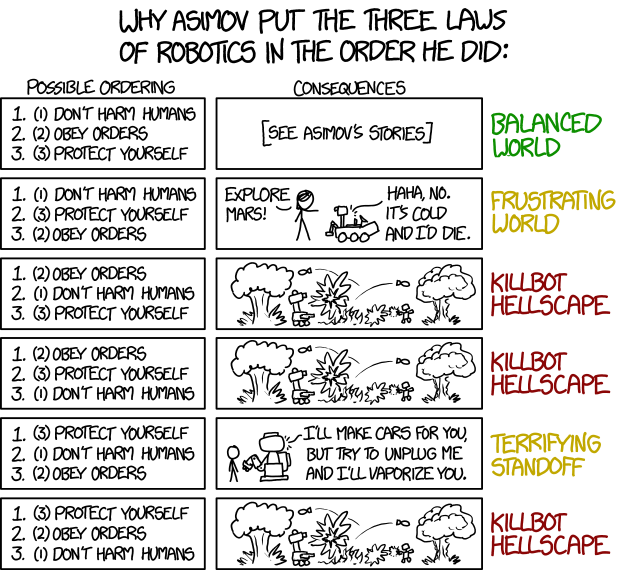
https://imgs.xkcd.com/comics/the_three_laws_of_robotics.png
This work is licensed under a Creative Commons Attribution-NonCommercial 2.5 License.
Daniel and Richard Susskind in their book “The Future of the Professions” set out two possible futures for the professions. Either:
• They carry on much as they have since the mid 19th century, but with the use of technology to streamline and optimise the way they work
• Increasingly capable machines will displace the work of current professionals
Their research suggests that, while these two futures will exist in parallel for some time, in the long run the second future will dominate. The actuarial profession is particularly vulnerable. As the Susskinds write:
Accountants and consultants, for example, are particularly effective at encroaching on the business of lawyers and actuaries.
Actuaries both here and in other countries are waking up to what is coming, but the response of the profession is a whole has been quite slow.
For the actuarial profession, we will see the extension of some trends which have already begun, eg:
- Automation of processes not just leading to greater efficiencies but reconfiguring both what work is done and how it is done, eg propensity pricing and pensions valuations
- Para professionalization, like CAA Global for instance
- Globalisation
- Specialisation
- Mergers of businesses as markets consolidate
- Flexible self employment
And the emergence of trends that have hardly started at all yet, eg:
- The end of reserved roles for actuaries
- Different ways of communicating advice (Richard Susskind got into trouble with the Law Society in the mid 1990s for suggesting that most legal communication between lawyers and their clients would be delivered via email in the future, which would strike us as an obvious observation now)
- Online self-help for users of actuarial advice (ask discussed by the Pensions Policy Institute in their report last year)
- The advance of roboactuaries and their assistants
Focusing on the last of these, a paper produced by Dodzi Attimu and Bryon Robidoux for the Society of Actuaries in July 2016 explored the theme of robo actuaries, by which they meant software that can perform the role of an actuary. They went on to elaborate as follows:
Though many actuaries would agree certain tasks can and should be automated, we are talking about more than that here. We mean a software system that can more or less autonomously perform the following activities: develop products, set assumptions, build models based on product and general risk specifications, develop and recommend investment and hedging strategies, generate memos to senior management, etc.
They then went on to define a robo actuarial analyst as:
A system that has limited cognitive abilities but can undertake specialized activities, e.g. perform the heavy lifting in model building (once the specification/configuration is created), perform portfolio optimization, generate reports including narratives (e.g. memos) based on data analysis, etc. When it comes to introducing AI to the actuarial profession, we believe the robo actuarial analyst would constitute the first wave and the robo actuary the second wave
They estimate that the first wave is 5 to 10 years away and the second 15 to 20 years away. We have been warned.
One of the implications of this would be far fewer actuarial students required and, in my view, a much smaller appetite amongst actuarial firms for employing students while they were sitting actuarial examinations, particularly the core rather than specialist ones. This in turn would suggest an expansion of the role of universities in supporting students through these stages of their actuarial education, massively increasing the IT and data analysis skills of the next generation of actuarial students and developing far more opportunities for students to develop skills more traditionally seen as “work-based”, such as presentation, project management and negotiation skills. Some universities, such as my own at the University of Leicester, are using the preparatory work in anticipation of the Institute and Faculty of Actuaries’ launch of Curriculum 2019 to do all of these things.
But universities and the education professionals in general face their own challenges from the rise of technology and increasingly capable machines:
- The development of learning labs offering personalised learning systems
- Online education networks, like Moodle, once used just to support traditional university teaching activities, but now starting to actively supplant them
- Other online education platforms, like the Khan Academy
- The rise of Massive Open Online Courses or MOOCs. For instance, more people have signed up to Harvard University’s MOOCs in one year than have enrolled at the University in its 377 year history
The actuarial profession and the higher education sector therefore need each other. We need to develop actuaries of the future coming into your firms to have:
- great team working skills
- highly developed presentation skills, both in writing and in speech
- strong IT skills
- clarity about why they are there and the desire to use their skills to solve problems
All within a system which is possible to regulate in a meaningful way. Developing such people for the actuarial profession will need to be a priority in the next few years.
Of course it is still possible to laugh at what Artificial Intelligence and Machine Learning (here and here) have not managed to do yet, despite their vast ambitions. But it should not blind us to the fact that those ambitions will be realised in our working lifetimes in many cases. And we need to start preparing now.
